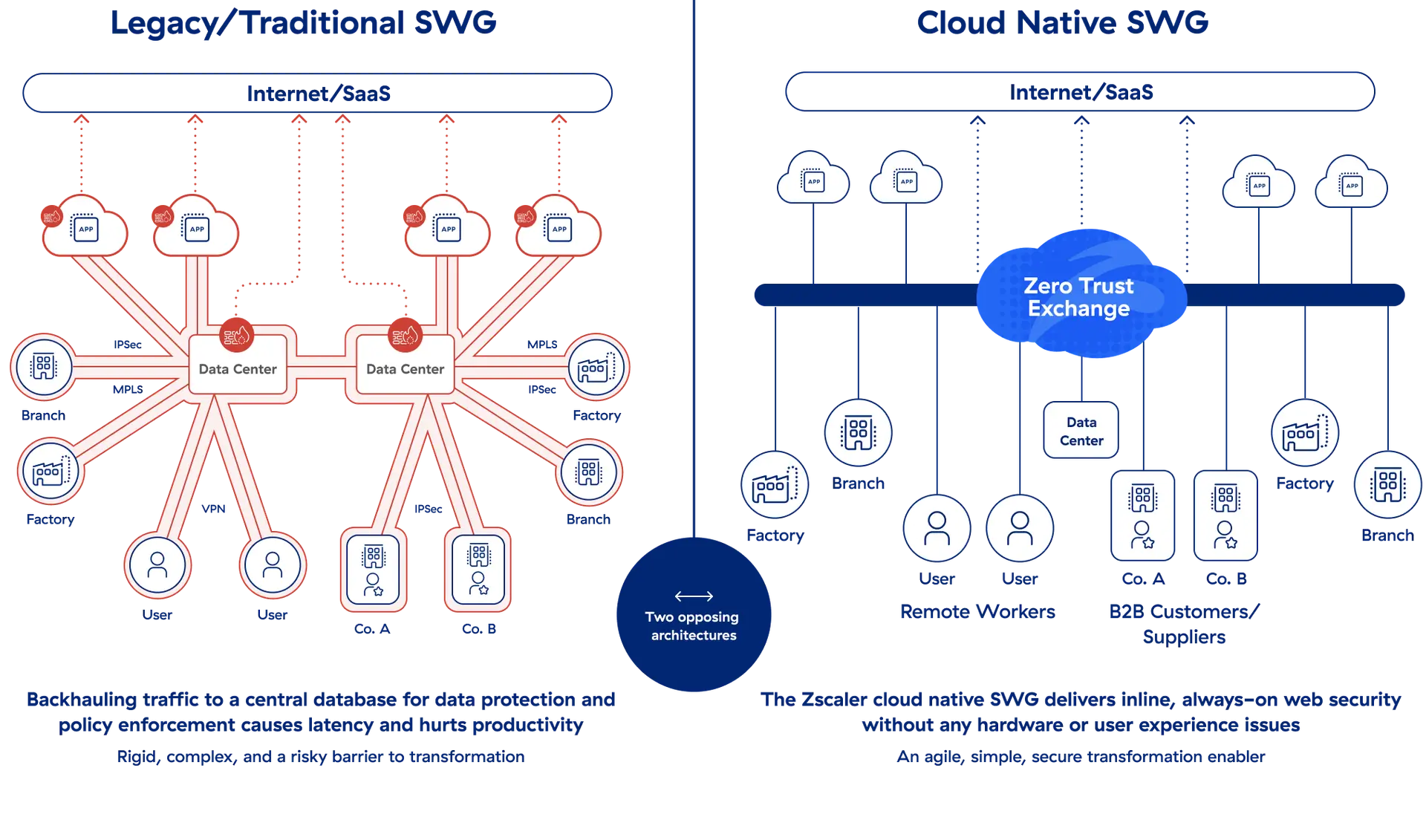Blog Zscaler
Recevez les dernières mises à jour du blog de Zscaler dans votre boîte de réception
S'abonner
Cloud Native Secure Web Gateway: Adaptive Protection Legacy SWGs Can’t Match
Rapid adoption of cloud-based apps and services has transformed business, enabling greater agility, scalability, and cost savings. But it has also introduced security challenges: countless new attack paths and a massive volume of threats. Detecting and stopping those threats at scale requires a new technology approach.
Cloud native secure web gateways (SWG, pronounced “swig”) address these challenges, enabling organizations to protect their employees from malicious websites, malware, and other cyberthreats lurking in web traffic. In this blog, we’ll explore the weaknesses of legacy SWGs, the key components of a cloud native SWG, and how to choose an effective SWG to protect your organization in hybrid environments.
Securing the hybrid workforce requires zero trust
Hybrid work is here to stay. The dynamic nature of modern work has shifted the boundaries of traditional offices, creating a new norm in which all companies must empower employees while protecting the organization from cyberthreats. This new norm also brings challenges in securing access to SaaS applications and the internet.
Reliance on cloud-based applications and services has transformed business operations. However, it has also introduced new vulnerabilities that traditional perimeter-based security measures often fail to address.
SaaS applications, the gateway to valuable data, are now accessed from anywhere, including beyond the confines of the corporate network. Distributed access increases the risk of unauthorized intrusions and data breaches. Therefore, it is imperative to adopt a zero trust security strategy, empowering users to securely connect to apps and the internet.
The internet offers countless tools for a hybrid workforce, but it also provides an attack surface threat actors can use to target your organization. Malicious websites, phishing scams, and cyberattacks pose constant threats: a single click can compromise a device, potentially leading to the theft of sensitive data and wreaking havoc in an organization's IT infrastructure.
A SWG is a key tool for defending against these internet-based threats. An effective SWG inspects and filters all internet traffic at scale — encrypted or not — and blocks malicious traffic. By blocking access to malicious websites and employing advanced inline threat detection, an effective SWG shields users from the perils of the internet and safeguards an organization’s sensitive data.
Securing access to SaaS applications and the internet isn’t an option; it’s a necessity. A SWG stands as a cornerstone of a security strategy that provides organizations the ability to protect their sensitive information and stay compliant.
Why legacy secure web gateways are failing
Many security vendors offer a SWG deployed as an on-premises appliance or cloud-based service that supposedly simplifies management, maintenance, and upgrades. However, while these virtualized SWGs can operate in hybrid environments, they still share many of the disadvantages of their hardware predecessors. They were designed for a time when most applications were hosted on-premises and internet traffic was relatively simple.
Today's cloud-based applications and services are distributed and use newer network protocols, making them much more complex. They also generate exponentially more traffic, creating challenges for virtualized SWGs based on legacy approaches:
- Lack of visibility and control to protect against modern threats: Legacy SWGs are often blind to encrypted traffic and unable to inspect it for malicious content. Since 95% of all internet traffic is now encrypted, inspecting it is essential.
- Can't keep up with innovations in cloud computing: New cloud-based apps and services are constantly being released, and legacy SWGs cannot quickly adapt to these changes, leaving organizations vulnerable to new threats.
- Too expensive to deploy and maintain: Legacy SWGs require specialized hardware and software, and they can be complex to manage, making them a poor fit for organizations with limited budgets or resources.

In short, legacy SWGs are failing to meet modern organizations’ needs. Now, let’s look at what defines a cloud native SWG capable of securing today’s distributed workforce and applications.
Key components of a cloud native secure web gateway
The foundation of a cloud native SWG should be a zero trust architecture, combined with real-time threat intelligence, advanced threat protection, secure web browsing, data loss prevention, and AI/ML-based protection. Let’s briefly look at each of these:
- Zero trust architecture assumes all users and devices are untrusted and must be verified before being granted access to network-based resources. This is done by implementing strong authentication and authorization mechanisms combined with continuously monitoring user activity for suspicious behavior.
- Real-time threat intelligence provides up-to-date information about the latest threats, such as malware, phishing attacks, and zero-day vulnerabilities. Security teams use this information to block access to known malicious websites as well as identify and mitigate potential threats.
- Advanced threat protection uses various techniques, including sandboxing, URL filtering, and intrusion detection, to detect and block advanced threats such as malware, ransomware, and phishing attacks.
- Secure web browsing via browser isolation provides a safe and secure way for users to access the internet. This is done by blocking access to malicious websites and preventing users from downloading harmful content. Secure web browsing also prevents copy-and-paste of sensitive information into websites.
- Data loss prevention (DLP) stops sensitive data from being leaked or stolen. This is done by scanning all data that passes through the SWG for sensitive information, such as credit card numbers, social security numbers, and intellectual property.
- AI/ML-based protection uses artificial intelligence and machine learning to identify and block new and emerging threats. This is done by analyzing large amounts of data to identify patterns and anomalies that indicate a threat.
By combining these key components, cloud native SWGs provide businesses with a comprehensive solution for protecting their users and data from internet-borne risks.
Cloud native secure web gateway benefits
Cloud native SWGs offer organizations several advantages over legacy SWGs, including:
- Enhanced security efficacy: Cloud native SWGs can identify and block the latest cyberthreats, including zero-day attacks and advanced persistent threats (APTs). They do this with real-time threat intelligence, sandboxing, ML, inline traffic inspection, and other security features.
- Improved performance: Cloud native SWGs are highly scalable and efficient, able to handle large volumes of traffic without compromising performance. They can also provide real-time protection to safeguard businesses against sophisticated threats.
- Reduced costs: Because they are easier to deploy and manage, cloud native SWGs are more cost-effective than legacy SWGs.
- Increased scalability: High scalability enables cloud native SWGs to easily accommodate traffic spikes. They can also be deployed in multiple locations, which can improve performance and reliability.
- Improved agility: Cloud native SWGs can be deployed and configured more quickly than legacy SWGs, as well as easily updated with new features and security patches. This allows businesses to respond quickly to changing threats and business needs.
Choosing the right cloud native secure web gateway
To choose a SWG that helps secure your cloud environment, consider these key factors:
- Robust security features: Choose a SWG that provides comprehensive security with zero trust architecture, multifactor authentication, and advanced threat protection. It should safeguard against malware, phishing attacks, and emerging cyberthreats.
- Inspection of encrypted traffic at scale without impacting the user experience: A cloud native SWG can inspect 100% of TLS/SSL traffic to find and stop threats—a must-have with 86% of threats now delivered over encrypted channels.
- Support for the latest network protocols: A future-proof SWG must inspect traffic using the latest network protocols, including IPv6 and HTTP/2, which support more robust security while enabling superior user experiences. IPv6 provides more efficient routing without the need for network address translation (NAT). IPv6 adoption stands at about 48% and growing, so your SWG of choice needs to support it.
- Superior performance and scalability: Consider the SWG's ability to handle your traffic without compromising speed or user experience. It should seamlessly scale its traffic inspection to accommodate demand, providing optimal performance even during traffic surges.
- Seamless integration: Look for a SWG that integrates effortlessly with your existing security toolset, including firewalls, intrusion detection systems, and security information and event management (SIEM) tools. This integration streamlines threat management and provides centralized visibility and control over your security posture.
- Cost-effective solution: Compare total cost of ownership, including licensing fees, maintenance costs, and ongoing support. Choose a solution that offers a cost-effective approach that delivers strong security.
- Real-world validation: Read customer reviews and case studies to gain insights into the practical experiences and benefits of using a particular cloud native SWG. This feedback can provide valuable information about reliability, performance, and customer satisfaction.
Next-level web security with Zscaler SWG
Part of the Zscaler Zero Trust Exchange™, our cloud native SWG provides comprehensive security services applied inline between your users, the web, and SaaS apps. By terminating every connection inline, inspecting all internet traffic, and applying a user-centric security and access policy, you can eliminate the attack surface, prevent compromise, stop lateral movement, and halt sensitive data loss.
Our AI-powered SWG provides innovative features that legacy technical approaches can’t match:
- AI-powered proactive defense capabilities:
- Phishing detection: Detect and block patient zero phishing pages inline with advanced AI-based detection.
- Command-and-control (C2) detection: identify and stop attacks from never-before-seen botnets inline, including advanced evasion techniques.
- Browser isolation: Robust, proprietary AI models and one-click configurations automatically identify and isolate risky, suspicious, or malicious websites.
- Full TLS/SSL traffic inspection: Regardless of the network protocols used for the underlying data transport, Zscaler SWG can fully inspect traffic at scale while supporting protocols including IPv4 as well as the newer IPv6 and HTTP/2.
- Dynamic, risk-based access policies: Future-proof your defenses and stop active attacks with risk-based dynamic policies that continuously analyze content, domains/URLs, users, devices, and applications.
- Correlated threat insights: Drastically improve response times with contextualized, correlated alerts that provide insight into threat scores, affected assets, severity, and more.
- Cyber risk assessment: Automatically identify your organization’s risk based on configuration with integrated best practice recommendations to improve security posture.
- HTTP/2 inspection: Gain end-to-end performance improvements and maintain granular policy enforcement for all HTTP/2 traffic at scale.
A proven cloud native SWG is a key part of an adaptive security service edge (SSE) that provides multiple security capabilities. Zscaler customers can take advantage of our AI-powered SWG that is included with all editions of Zscaler Internet Access™.
Zscaler was named a Leader in SSE for the third consecutive year in the Gartner Magic Quadrant for Security Service Edge report. To further understand the capabilities of a leading SSE solution that includes a cloud native SWG, download your copy now.
Cet article a-t-il été utile ?
Recevez les dernières mises à jour du blog de Zscaler dans votre boîte de réception
En envoyant le formulaire, vous acceptez notre politique de confidentialité.




